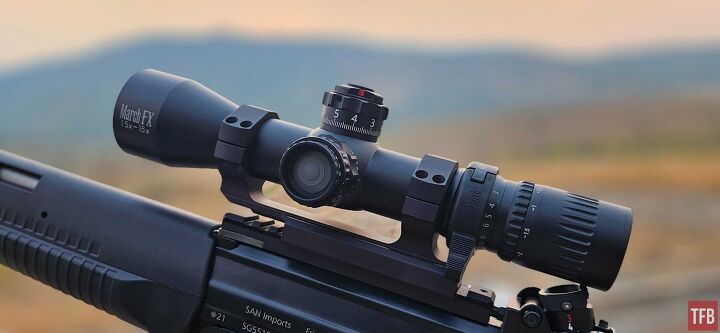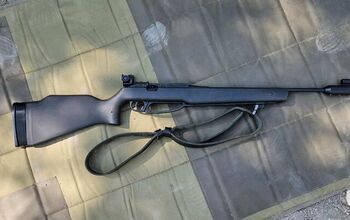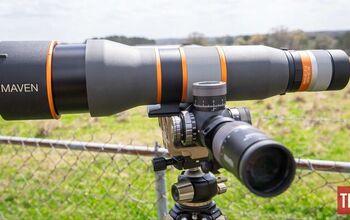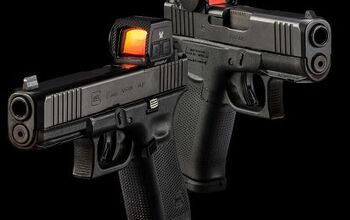TFB Review: March Scopes FX 1.5-15x42 Dual Focal Plane Scope

“Dual focal plane” and “March Scopes” are not terms in the vernacular of the average shooter. But when the opportunity came along to test out a March Scopes FX 1.5-15x42 with such a reticle, I was fully on board to try it out. This is a unique scope with a lot of capability, and I hope you find this review informative.
Optics Reviews @ TFB:
- TFB Review: What Optic For A Steyr Scout? (Part 2)
- TFB Review: Pulsar Thermion 2 XL50 LRF - HD Thermal Riflescope
- TFB Review: Primary Arms SLx 3x MicroPrism
- TFB Review: Leupold Mark 4HD 1-4.5X25 M5C3 SFP Scope + Torture Test
- TFB Review: Trijicon Credo 1-10x28
There are no disclosures needed for this review. I do not have a prior relationship with March Scopes. March did not pay me for this review. They let me borrow this scope for a few months, and I paid to ship it back when I was done with it. I also paid for the ammo used in the review.
Background
If you have never heard of DEON Optical or March Scopes, you are not alone. The company started making scopes in 2004. March produces high-end glass, and many of their products are aimed at competitions like ELR, F-Class, and Benchrest. But while they are popular in those circles, these are not the kind of scopes that tend to be on the shelf at your local gun store.
There is no marketing pizzaz in the model name. The D15V42FDIMLX won’t win any advertising or branding awards, but this is not a scope made for splashy magazine ads or social media. It is made to be the optimal “do all” rifle scope, without much concern for the price point. The FX 1.5-15x42 is heavy on both features and performance.
Features
March spares no expense with the features, including a unique locking turret system. The “Shuriken lock” is an X-shaped mechanism on the top of each turret that locks the turrets in place. When the turrets are locked there are small visible red sections. In the unlocked position, they are white. The shuriken locks are easy to move between locked and unlocked positions, and easily visible without taking your head off the stock.
The reticle is illuminated, with a center dot that is fairly bright thanks to the fiber optics that pass the illumination to the reticle. The control layout is a little unique. A central power button turns the illumination on and off, much like the Leupold Firedot. But that button does not control the brightness. There is a small knurled ring at the extreme left side of the parallax knob with six numbered brightness settings. I like this design a lot.
March Scopes includes a clamp-on plastic throw lever in the box. I mounted this on the scope and left it on for the entire review. This scope is a natural fit for rifles that need to do all things well, and rapidly changing between low and high magnification is important in that role. I would prefer if the throw lever was built into the magnification ring rather than being a plastic accessory piece.
The diopter adjustment is labeled, which is a very nice touch. Rather than a small insert at the rear of the scope like many other scopes, the eyepiece turns to adjust the diopter. Once the eyepiece is focused, there is a set screw that tightens against it to hold the adjustment in place, unlike lesser units that move with rough handling and lose the setting. This is a great touch that feels at home on a scope like this.
This attention to detail continues to the turret reset and zero stop functions. Setting the turrets back to zero is easy, and only requires loosening three 1.5mm screws, turning the turret to zero, and tightening the screws again. This works the same on both the elevation and windage turrets. The elevation turret has a very novel zero stop. With the scope set to zero, simply use a coin to turn the small wheel in the center of the turret. Once that screw bottoms out the zero stop is set. With the zero stop set, there is still some downward travel remaining.
Specifications
Length: 10.6 inches
Eyepiece Diameter: 1.6 inches
Objective Lens Diameter: 42 mm
Objective Bell Outer Diameter: 2.0 inches
Weight: 24.7 Ounces
Field of View (Low): 70.6 Feet at 100 Yards
Field of View (High): 6.9 Feet at 100 Yards
Dual Focal Plane?
The most unique feature of the D15V42FDIMLX is the reticle. At this point we probably all know what first focal plane and second focal plane reticles are. Second focal plane reticles are most common and do not change as magnification changes. With a hunting reticle like a simple duplex, this is just fine. But when there are markings in the reticle to compensate for ballistic drop, that becomes an issue. The mark that indicates the 300-yard drop at 9x will be inaccurate by as much as several hundred yards at 3x.
In contrast, a first focal plane reticle expands and decreases in size in a constant relationship with the image in the scope. Thus, a drop marker that relates to 300 yards at 9x would also be a 300-yard mark at 3x, if you can see it. One of the critical tradeoffs to first focal plane reticles is that they are not always legible at low magnifications.
A dual focal plane reticle puts part of the second focal plane, and part in the first focal plane. The heavy crosshairs at 3-, 6-, and 9-o’clock are in the second focal plane. They remain thick enough to be seen but thin enough to be unobtrusive throughout the magnification range. The center illuminated dot is also in the second focal plane so it stays the ideal size. But the reticle also includes a triangular grid of elevation and windage dots in the first focal plane. Those marks are almost invisible at minimum magnification but become visible as magnification increases. This works well because those marks are only really useful at higher magnification.
This sounds a little complicated, but in use it is highly intuitive. When you need a clear field of view at low power, you have one. When you need extra marks for longer-range use, they are present. There are no compromises in the reticle design as there are in SFP or FFP options. The illuminated center dot doesn’t get in the way at 15x because it always remains a fine point. A simple crosshair is visible at all magnifications, but those outer lines do not obscure the target when zoomed in. The dual focal plane is the best of both worlds.
Sighting In
I ran the FX 1.5-15x42 on three guns: a PTR-91, Sig SG551, and PSA Sabre 15. I used a Leupold 34mm cantilever mount on all guns. Once everything was torqued down to spec, getting the scope zeroed was easy. The turrets tracked accurately and consistently. I ran a series of box tests on the indoor 100-yard range at TNT Guns & Range in Murray, Utah, where my results were unaffected by wind. The tracking was accurate enough that I could not measure any error. A scientific laboratory might be able to measure some variation, but for all practical purposes it was dead on.
On The Range - Close Quarters
The 1.5-power bottom end is a slightly odd experience. The prevalence of optics like LPVOs with 1x low ends and red dots has spoiled us. 1.5x is not quite as fast as those, but is not far off either. Trijicon calls it the “Bindon Aiming Concept” to use a magnified, illuminated optic with both eyes open. This method also works with a completely obscured sight, as in the Armson OEG. The FX 1.5-15x42 has a large eye box, and it is easy to find the red dot when moving quickly. Even off-axis from the tube, as long as the illuminated dot was visible I could still make hits even if my viewing angle prevented me from getting an image through the scope.
On 1.5x with the center dot illuminated, I ran a series of drills from zero to ten yards. It worked probably 80% as well as a true 1x optic, and that is pretty solid. Scopes like this need to do both close-range and distance work passably. Improvements in close-range performance tend to hurt long-range performance, and the reverse is true as well. March favored long-range use with this scope, but it remains usable for close and fast work.
On The Range - At Distance
Over the course of the review, I shot several hundred rounds at ranges out to 700 yards. The March FX 1.5-15x42 works up close, but it shines at range. The dual focal plane reticle is easy to use, with drop and wind deflection marks that are crisp and easy to use for holdovers. The combination of first and second focal plane elements just plain works and presents a legible reticle through the magnification range. And while there are not many circumstances where shooting at distance with a 1.5x scope is ideal, the huge field of view makes it easy to find targets before adding magnification to take a shot.
The scope also boasts excellent glass clarity and light transmission. It is easy to spot hits and misses in varied lighting conditions. On one range trip, I spotted for other shooters at 500 yards as the light faded past dusk. The added expense of premium glass shows its worth at first and last light, and this March scope was no exception to that rule.
I took a series of pictures to show the view through the scope at the different magnification levels. As with all images taken through a scope, take these with a grain of salt. They accurately show what the reticle looks like in relation to the tube, and how much “tunneling” is present from the scope tube. It does not convey the quality of the glass perfectly, but the glass quality is outstanding.
Though the March FX 1.5-15x42 has a 10x erector ratio, it is usable through the entire magnification range. Unlike 1-10x LPVOs, which are usually very compromised at the top end, the March FX still works at 15x. The eye box is noticeably narrower than at lower magnification, but not enough to make it difficult to use. The FX on 15x is much easier to use than an LPVO at 10x, in large part thanks to the large objective lens.
Another advantage over traditional LPVOs is the presence of a side parallax adjustment. Coupled with higher magnification, superb glass, and an intuitive reticle design, the FX lives to work at distance. But it accomplishes this while outperforming scopes at the low end. A 1.5x bottom end may not be as good as 1x, but it is infinitely easier to use than a 3x or 4x low end that is typical of scope with this upper magnification.
Market Comparison
As with most optics, the question often boils down to price. The D15V42FDIMLX retails for around $3,000 here in the United States. That puts it in the same price class as scopes like the Nightforce ATACR and Kahles 318i, but below the Tangent Theta and Zero Compromise price class. In my opinion, it belongs in that price bracket. There is great attention to detail in the design of this scope, and it has excellent glass quality.
Another comparable scope is the Elcan SpectreDR 1.5x/6x. That is a vastly different optic, but the 1.5x bottom end and design intent for use on carbines are the same. But the 15x top end and target turrets distinguish the March FX as a scope that belongs on an accurized rifle. The Elcan may have an advantage in durability and fits a slightly smaller form factor, but the March FX would be useful in a wider range of situations.
Conclusion
The March Scopes FX 1.5-15x42 is an impressive optic. It has a unique blend of features that allow it to do most things well, and some things exceptionally. The reticle, glass quality, and target turret turrets make it easy to score hits at distance. On the balance, this scope is meant more for precision work than close range use. But it still performs well at low magnification when close and fast are the name of the game. It is also adequately durable for use on carbines that are handled roughly and shot quickly, and in my use on 5.56 and 7.62 semi-auto rifles, the scope was unbothered by fast movement into barricades or rapid firing.
The dual focal plane reticle also blends the best of first and second focal plane scopes. I asked March’s engineer at SHOT Show why no one else was selling DFP scopes. His response was that the competition could not make it work. Perhaps that is true, or perhaps that was marketing puffery. But the system works extremely well, and I would love to see more DFP options in both the March lineup and the broader market.
One of the only downsides is the price, which at $3,000 is quite steep. March also has a small footprint here in the United States and it is very hard to see their optics in person before taking the plunge on that purchase. But if that price point is one you are comfortable with, and you need a scope for an accurate carbine that can also work in close quarters, the FX 1.5-15x42 dual focal plane is a compelling option.

AKA @fromtheguncounter on Instagram. Gun nerd, reloader, attorney, and mediocre hunter.
More by Daniel Y









































Comments
Join the conversation
Fantastic option for a DMR or SASS.
I have been using a March 3-24x44 scope on my hunting rifle since 2014. Very well built scope, clear glass, and an amazing range of magnification that does everything from up close pig hunting to long range shooting.